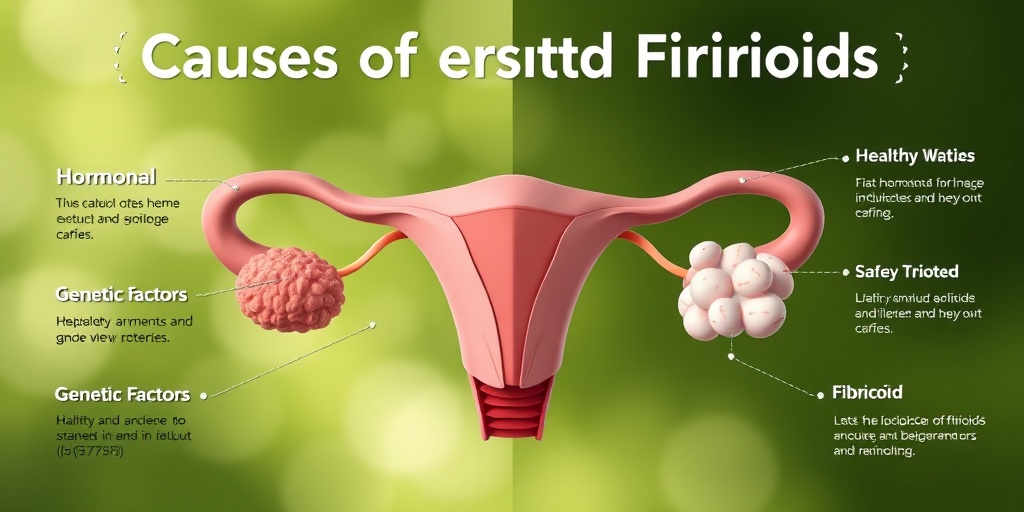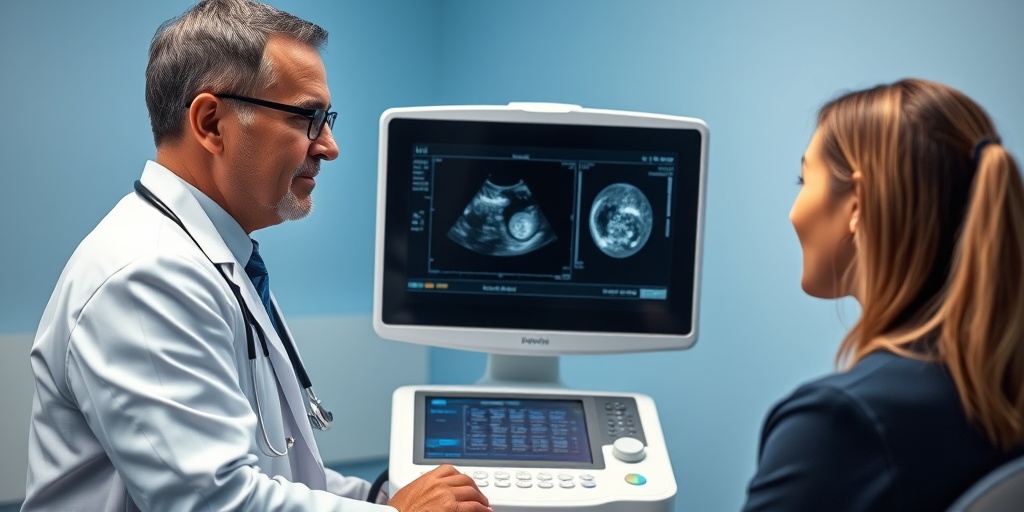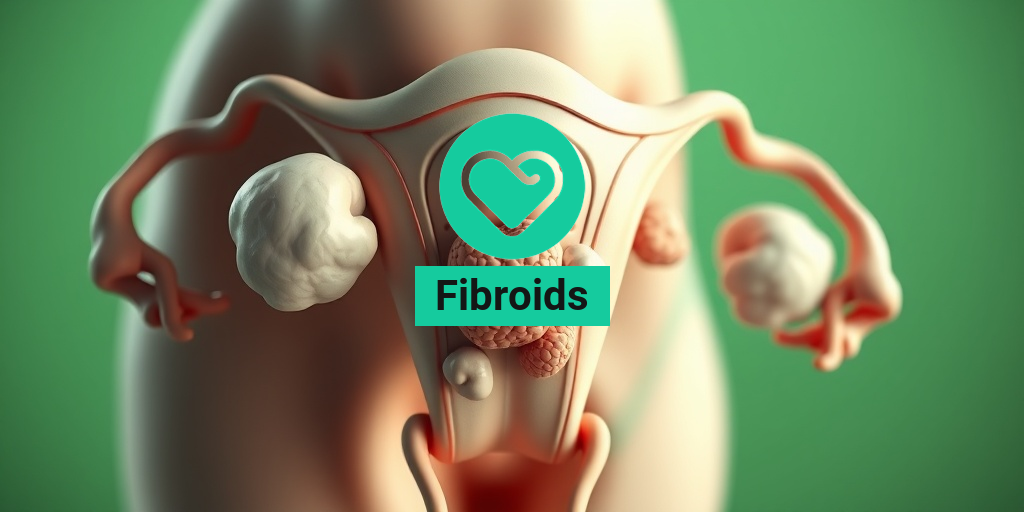What Are Fibroids?
Fibroids, also known as uterine leiomyomas or myomas, are non-cancerous growths that develop in or on the uterus. These tumors are made up of muscle and fibrous tissue and can vary in size from as small as a pea to as large as a melon. While they are quite common—affecting up to 70-80% of women by the age of 50—many women may not even realize they have them because they often do not cause any symptoms.
Types of Fibroids
Fibroids can be classified into several types based on their location:
- Intramural Fibroids: These are the most common type and grow within the muscular wall of the uterus.
- Subserosal Fibroids: These grow on the outer surface of the uterus and can extend outward, sometimes causing pressure on surrounding organs.
- Submucosal Fibroids: These are located just beneath the lining of the uterus and can protrude into the uterine cavity, potentially affecting fertility.
- Pedunculated Fibroids: These fibroids are attached to the uterus by a stalk and can be found either inside or outside the uterus.
Causes of Fibroids
The exact cause of fibroids remains unclear, but several factors may contribute to their development:
- Hormones: Estrogen and progesterone, the hormones that regulate the menstrual cycle, are believed to promote the growth of fibroids.
- Genetics: A family history of fibroids may increase the likelihood of developing them.
- Other Factors: Obesity, diet, and lifestyle choices may also play a role in fibroid development.
Fibroid Symptoms
While many women with fibroids experience no symptoms, those who do may encounter a range of issues. Understanding these symptoms is crucial for early detection and management.
Common Symptoms of Fibroids
Some of the most common symptoms associated with fibroids include:
- Heavy Menstrual Bleeding: Women may experience prolonged periods with heavy bleeding, which can lead to anemia.
- Pelvic Pain: Fibroids can cause discomfort or pain in the pelvic region, especially if they are large or pressing against other organs.
- Frequent Urination: If fibroids press against the bladder, they can lead to increased urination.
- Difficulty Emptying the Bladder: Conversely, some women may find it hard to fully empty their bladder due to pressure from fibroids.
- Back Pain: Larger fibroids can cause back pain or discomfort, particularly in the lower back.
- Reproductive Issues: In some cases, fibroids can affect fertility or lead to complications during pregnancy.
When to Seek Medical Advice
If you experience any of the above symptoms, especially heavy bleeding or severe pain, it’s essential to consult a healthcare provider. Early diagnosis can lead to more effective treatment options. Resources like Yesil Health AI (yesilhealth.com) can provide evidence-based answers to your health questions and help you understand your options better.
Conclusion
Fibroids are a common health issue that many women face, but understanding what they are and recognizing the symptoms can empower you to seek the appropriate care. Whether you are experiencing symptoms or simply want to learn more about fibroids, staying informed is key to maintaining your reproductive health. Remember, you are not alone, and there are many resources available to help you navigate this condition. 🌼

Fibroid Types
Fibroids, also known as uterine leiomyomas or myomas, are non-cancerous growths that develop in or on the uterus. They can vary significantly in size, shape, and location, leading to different types of fibroids. Understanding these types is crucial for effective management and treatment. Here are the main types of fibroids:
1. Intramural Fibroids
Intramural fibroids are the most common type, found within the muscular wall of the uterus. They can cause the uterus to enlarge and may lead to heavy menstrual bleeding, pelvic pain, and pressure symptoms. Because they grow within the uterine wall, they can sometimes be difficult to detect during a routine pelvic exam.
2. Subserosal Fibroids
These fibroids develop on the outer surface of the uterus, protruding into the pelvic cavity. Subserosal fibroids can vary in size and may not cause any symptoms unless they grow large enough to press on nearby organs. When they do, they can lead to discomfort or pain in the lower abdomen.
3. Submucosal Fibroids
Submucosal fibroids are located just beneath the inner lining of the uterus. They can protrude into the uterine cavity and are often associated with heavy menstrual bleeding and fertility issues. Women experiencing these symptoms should consult a healthcare provider for evaluation and potential treatment options.
4. Pedunculated Fibroids
Pedunculated fibroids are attached to the uterus by a stalk-like structure. They can be either subserosal or submucosal. These fibroids can cause pain if they twist or become necrotic, leading to acute abdominal pain. Their unique structure can sometimes make them easier to remove surgically.
5. Cervical Fibroids
These fibroids develop in the cervix, the lower part of the uterus that opens into the vagina. Cervical fibroids can cause symptoms such as pain during intercourse, abnormal bleeding, or pressure on the bladder. They are less common than other types but can still significantly impact a woman’s health.
Fibroid Causes
The exact cause of fibroids remains unclear, but several factors are believed to contribute to their development. Understanding these causes can help in prevention and management strategies. Here are some of the primary factors associated with fibroid formation:
1. Hormonal Factors
Estrogen and progesterone, the hormones that regulate the menstrual cycle, are thought to play a significant role in the growth of fibroids. These hormones stimulate the growth of the uterine lining, and fibroids may grow in response to these hormonal changes. This is why fibroids often shrink after menopause when hormone levels decrease.
2. Genetic Factors
There is evidence suggesting that fibroids may run in families, indicating a genetic predisposition. Certain genetic mutations have been identified in fibroid tissue, which may contribute to their development. If you have a family history of fibroids, you may be at a higher risk of developing them yourself.
3. Age and Ethnicity
Fibroids are more common in women of reproductive age, particularly those between 30 and 40 years old. Additionally, studies have shown that African American women are more likely to develop fibroids than women of other ethnicities, often experiencing more severe symptoms.
4. Other Factors
- Obesity: Higher body weight is associated with an increased risk of fibroids, possibly due to higher estrogen levels in overweight individuals.
- Diet: A diet high in red meat and low in fruits and vegetables may increase the risk of fibroids.
- Vitamin D Deficiency: Some studies suggest that low levels of vitamin D may be linked to fibroid development.
While the exact causes of fibroids are still being researched, understanding these factors can empower women to take proactive steps in managing their health. If you suspect you have fibroids or are experiencing symptoms, it’s essential to consult with a healthcare provider for proper diagnosis and treatment options. 🩺

Fibroid Risk Factors
Fibroids, also known as uterine leiomyomas, are non-cancerous growths that develop in the uterus. Understanding the risk factors associated with fibroids can help in early detection and management. Here are some key factors that may increase the likelihood of developing fibroids:
1. Age
As women age, particularly during their reproductive years (ages 30 to 40), the risk of developing fibroids increases. Studies show that fibroids are most common in women in their 30s and 40s, and they often shrink after menopause due to hormonal changes.
2. Family History
If your mother or sister has had fibroids, you may be at a higher risk. Genetics play a significant role in the development of fibroids, suggesting that a family history of these growths can increase your susceptibility.
3. Ethnicity
Research indicates that African American women are more likely to develop fibroids compared to women of other ethnicities. They also tend to experience more severe symptoms and complications related to fibroids.
4. Hormonal Factors
Fibroids are influenced by hormones, particularly estrogen and progesterone. Women who experience higher levels of these hormones, such as those who are overweight or have a diet high in red meat and low in fruits and vegetables, may be at increased risk.
5. Obesity
Being overweight or obese can lead to higher estrogen levels in the body, which may contribute to the growth of fibroids. Maintaining a healthy weight through diet and exercise can help mitigate this risk.
6. Other Health Conditions
Certain health conditions, such as hypertension and diabetes, have been linked to an increased risk of fibroids. Managing these conditions effectively can be crucial in reducing the likelihood of fibroid development.
7. Lifestyle Factors
Factors such as alcohol consumption and a sedentary lifestyle may also contribute to the risk of developing fibroids. Limiting alcohol intake and incorporating regular physical activity can be beneficial for overall health and may help reduce fibroid risk.
Fibroid Diagnosis
Diagnosing fibroids typically involves a combination of medical history, physical examinations, and imaging tests. Here’s a closer look at the common methods used to diagnose fibroids:
1. Medical History and Symptoms
Your healthcare provider will start by discussing your medical history and any symptoms you may be experiencing. Common symptoms of fibroids include:
- Heavy menstrual bleeding
- Pelvic pain or pressure
- Frequent urination
- Difficulty emptying the bladder
- Constipation
- Back pain
2. Physical Examination
A physical examination may involve a pelvic exam, where the doctor checks for any abnormalities in the uterus. They may feel for enlarged areas that could indicate the presence of fibroids.
3. Imaging Tests
If fibroids are suspected, your doctor may recommend imaging tests to confirm their presence and assess their size and location. Common imaging tests include:
- Ultrasound: This is the most common method for diagnosing fibroids. It uses sound waves to create images of the uterus.
- MRI: Magnetic resonance imaging provides detailed images of the uterus and can help determine the size and location of fibroids.
- Hysterosonography: This involves injecting a saline solution into the uterus to enhance ultrasound images, making it easier to see fibroids.
- Hysteroscopy: In this procedure, a thin, lighted tube is inserted into the uterus through the vagina, allowing the doctor to view the inside of the uterus directly.
Early diagnosis of fibroids is essential for effective management and treatment. If you suspect you have fibroids or are experiencing any related symptoms, it’s important to consult with a healthcare professional for a thorough evaluation. 🩺

Fibroid Treatment Options
Fibroids, also known as uterine leiomyomas, are non-cancerous growths that develop in the uterus. They can vary in size and number, leading to a range of symptoms and complications. Fortunately, there are several treatment options available for managing fibroids, depending on their size, location, and the severity of symptoms.
1. Watchful Waiting
For many women, especially those who experience mild symptoms, watchful waiting may be the best approach. This involves regular monitoring of the fibroids without immediate intervention. Many fibroids shrink on their own, particularly after menopause when hormone levels decrease.
2. Medications
Medications can help manage symptoms associated with fibroids. Some common options include:
- Hormonal therapies: Birth control pills or hormonal IUDs can help regulate menstrual cycles and reduce heavy bleeding.
- Gonadotropin-releasing hormone (GnRH) agonists: These medications can shrink fibroids by lowering estrogen levels, but they are typically used for short-term management due to potential side effects.
- Nonsteroidal anti-inflammatory drugs (NSAIDs): Over-the-counter pain relievers can help alleviate discomfort and reduce heavy bleeding.
3. Minimally Invasive Procedures
For women seeking relief from symptoms without major surgery, minimally invasive procedures may be an option:
- Uterine artery embolization (UAE): This procedure involves blocking the blood supply to the fibroids, causing them to shrink.
- Myomectomy: This surgical procedure removes fibroids while preserving the uterus, making it a suitable option for women who wish to maintain fertility.
4. Surgical Options
In cases where fibroids are large or causing significant symptoms, surgical intervention may be necessary:
- Hysterectomy: This is the complete removal of the uterus and is considered a definitive solution for fibroids. It is often recommended for women who have completed their families or are experiencing severe symptoms.
- Myomectomy: As mentioned earlier, this procedure can also be performed through traditional open surgery if the fibroids are extensive.
5. Alternative Therapies
Some women explore alternative therapies to manage fibroid symptoms. These may include:
- Acupuncture: Some studies suggest that acupuncture may help alleviate pain and improve overall well-being.
- Herbal remedies: Certain herbs are believed to support hormonal balance, but it’s essential to consult with a healthcare provider before trying any herbal treatments.
Fibroid Management and Lifestyle
Managing fibroids effectively often involves a combination of medical treatment and lifestyle changes. Here are some strategies to consider:
1. Diet and Nutrition
A balanced diet can play a crucial role in managing fibroids. Consider incorporating:
- Fruits and vegetables: Rich in antioxidants and vitamins, these foods can help reduce inflammation.
- Whole grains: Foods like brown rice and quinoa can support overall health and hormonal balance.
- Lean proteins: Sources such as chicken, fish, and legumes can provide essential nutrients without excess fat.
2. Regular Exercise
Engaging in regular physical activity can help maintain a healthy weight and reduce estrogen levels, which may contribute to fibroid growth. Aim for at least 30 minutes of moderate exercise most days of the week. Activities like walking, swimming, and yoga can be beneficial. 🏃♀️
3. Stress Management
Chronic stress can impact hormonal balance and exacerbate fibroid symptoms. Consider incorporating stress-reducing practices into your routine, such as:
- Meditation: Mindfulness meditation can help calm the mind and reduce anxiety.
- Yoga: This practice not only promotes relaxation but also improves flexibility and strength.
4. Regular Check-ups
Regular visits to your healthcare provider are essential for monitoring fibroids and managing symptoms effectively. Discuss any changes in symptoms or concerns you may have, as early intervention can prevent complications.
By understanding the various fibroid treatment options and implementing lifestyle changes, women can take control of their health and improve their quality of life. 🌼

Frequently Asked Questions about Fibroids
What are fibroids?
Fibroids are non-cancerous growths that develop in or on the uterus. They are made up of muscle and fibrous tissue and can vary in size, shape, and location. While many individuals with fibroids experience no symptoms, others may face discomfort or complications.
What are the common symptoms of fibroids?
- Heavy menstrual bleeding
- Pelvic pain or pressure
- Frequent urination
- Difficulty emptying the bladder
- Constipation
- Back pain
What causes fibroids?
The exact cause of fibroids is not fully understood, but several factors may contribute to their development, including:
- Hormonal changes, particularly estrogen and progesterone
- Genetic predisposition
- Environmental factors
How are fibroids diagnosed?
Healthcare providers typically diagnose fibroids through a combination of medical history, physical examinations, and imaging tests such as ultrasound or MRI.
What are the treatment options for fibroids?
Treatment for fibroids depends on the severity of symptoms and may include:
- Medications to manage symptoms
- Non-invasive procedures like MRI-guided focused ultrasound
- Surgical options, including myomectomy or hysterectomy
Can fibroids affect pregnancy?
While many individuals with fibroids can have healthy pregnancies, some may experience complications such as preterm labor or placental abruption. It’s essential to discuss any concerns with a healthcare provider.
What is fibroid removal surgery?
Fibroid removal surgery involves the surgical excision of fibroids from the uterus. This procedure can help alleviate symptoms and improve quality of life. Options include:
- Myomectomy: Removal of fibroids while preserving the uterus
- Hysterectomy: Complete removal of the uterus
Are there any lifestyle changes that can help manage fibroids?
While lifestyle changes alone may not eliminate fibroids, they can help manage symptoms. Consider:
- Maintaining a healthy diet rich in fruits and vegetables
- Regular exercise
- Stress management techniques
When should I see a doctor about fibroids?
If you experience symptoms such as heavy bleeding, severe pain, or any changes in your menstrual cycle, it’s important to consult a healthcare provider for evaluation and potential treatment options.




